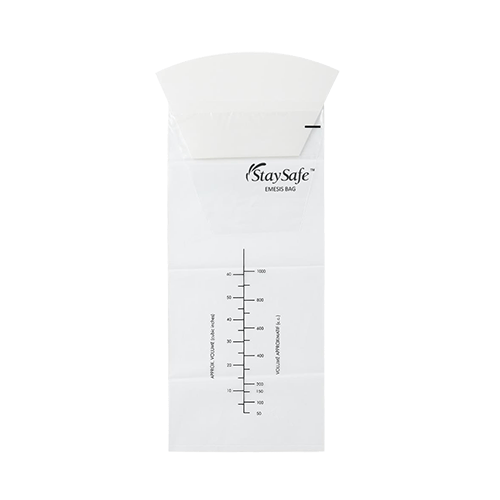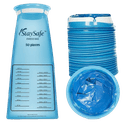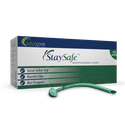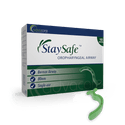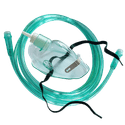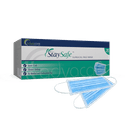Emesis Bag
Material
Type
Volume
Color
Packaging
What is an Emesis Bag?
An Emesis Bag is a single-use bag that has been specially designed to contain vomit or urine. It is made from leak-resistant materials and intended to reduce contamination and smell. Emesis bags are used in settings where individuals may be prone to nausea and vomiting, such as healthcare facilities or transportation.
These types of bags are also known as vomit bags, sickness bags, barf bags, or motion sickness bags. They are manufactured using low-density polyethylene (LDPE) or high-density polyethylene (HDPE) and are available in either 1000ml or 1500ml in either blue, white, or clear.
AdvaCare Pharma is a trusted manufacturer and global exporter of Emesis Bags. Our medical disposables are produced in strategically-located facilities spread across China, India, and the USA. Our production factories are compliant with the stringent regulations necessary for CE/ISO certification, and we regularly inspect our facilities to ensure they meet these high standards.
Product Specifications
Features
The Emesis Bag features a spill-proof design that is equipped with an inner seal, ensuring a secure and hygienic containment of bodily fluids.
The wide and rigid ring provides both stability and ease of use during collection. The paper funnel type is a simpler, lighter, more portable, and disposable option.
The inclusion of graduations on the bag allows for the easy monitoring of fluid volume, which can help provide accurate measurements for medical assessments.
Emesis bags can be made of LDPE or HDPE.
LDPE (low-density polyethylene) is a flexible and lightweight material resistant to tearing and punctures, making it a good choice for holding vomit or other bodily fluids. It is a cost-effective material that can be easily disposed of after use.
HDPE (high-density polyethylene) is a strong and durable material that is resistant to tearing and punctures, which can help to prevent leakage and ensure proper containment of bodily fluids.
Why are we a top Emesis Bag manufacturer?
AdvaCare Pharma, a leading global supplier, specializes in manufacturing Emesis Bags and a wide range of medical disposables for waste disposal. A comprehensive STED dossier accompanies each of our products, assuring our partners and distributors of consistent adherence to the highest quality standards in our medical supplies.
Leveraging our extensive industry experience, we have established a distribution network spanning 65 markets worldwide. Our business model prioritizes forging strong partnerships with our distributors, and our dedicated team offers unparalleled support throughout the entire process, from supply chain coordination and registration assistance.
Uses
What is an Emesis Bag used for?
An Emesis Bag is a great tool for staff in healthcare and various other settings as the bags provide a reliable means to safely contain and expedite the correct disposal of bodily fluids, especially vomit. These specialized bags are meticulously designed to not only capture such fluids but also minimize contamination and control any associated odors. Emesis Bags find widespread use in healthcare facilities, during travel, and in emergency care situations, where individuals may experience nausea and vomiting.
Through the successful isolating and managing of bodily fluids, these bags help to retain a clean and hygienic environment while supporting the comfort and well-being of individuals that are in distress.
How is an Emesis Bag used?
Using an Emesis Bag is a simple and effective process. When an individual experiences nausea or the need to vomit, they can readily utilize the Emesis Bag by holding it open and positioning the provided opening near their mouth. This strategic design allows for the direct collection of vomit, providing a hygienic and mess-free experience.
After use, seal the bag, not only to prevent any potential leakage but also to contain and eliminate the associated unpleasant odors. This conscientious approach to usage upholds the maintenance of a sanitary and comfortable environment, particularly for those in hospital care or other settings where Emesis Bags are employed.
How should Emesis Bags be stored?
Proper storage of unused Emesis Bags is paramount to preserving their functionality and integrity. These bags should be stored in an environment shielded from direct sunlight and protected from sources of heat. It is advisable to adhere meticulously to any specific storage instructions provided on the original packaging.
Through conscientiously following these guidelines, you can guarantee that Emesis Bags remain in their ideal condition and are readily available for use when needed.
How should Emesis Bags be disposed of?
The disposal of Emesis Bags demands careful consideration to minimize any potential contamination and the spread of pathogens. After each use, it is of utmost importance to seal the bag to eliminate any risk of leakage or exposure to its contents.
Emesis Bags are typically categorized as medical or biohazardous waste, necessitating disposal in strict accordance with local regulations and guidelines.
Complying with these established disposal protocols is required not only for proper handling but also to mitigate any potential health risks associated with the containment of bodily fluids. Encouraging the responsible and hygienic disposal of Emesis Bags assists in maintaining the safety and well-being of individuals and the environment alike.
What are the advantages of using Emesis Bags during travel?
Emesis Bags are invaluable for individuals traveling, especially on airplanes, buses, or ships, where motion sickness or other factors can lead to nausea and vomiting. The advantages of using Emesis Bags in such situations are multifaceted.
These bags provide a quick and accessible means for travelers to manage sickness discreetly. Their design allows or minimal spillage and odor, making them a practical choice for sustaining a pleasant travel experience. They contribute to a more sanitary travel environment for both passengers and crew.
Do Emesis Bags serve any purposes beyond nausea and vomiting?
While Emesis Bags are primarily designed for managing nausea and vomiting, they can have additional applications. In certain situations, these bags can be used to contain other bodily fluids, such as urine.
The leak-resistant and odor-control features of Emesis Bags make them a versatile tool for handling various liquid waste materials when needed, creating a clean and hygienic process.
What considerations should individuals keep in mind when selecting between LDPE and HDPE Emesis Bags?
Choosing between LDPE (low-density polyethylene) and HDPE (high-density polyethylene) Emesis Bags depends on specific requirements. LDPE bags are flexible, lightweight, and cost-effective, making them suitable for standard usage.
HDPE bags offer increased strength and puncture resistance, making them preferable in settings where a higher risk of tears or punctures exists, such as emergency rooms or surgical units. Individuals should consider the intended application and risk factors when deciding which type of Emesis Bag to use to obtain the best performance.
How are Emesis Bags used in hospitals?
Emesis Bags are used in hospital settings, primarily in managing patients who experience nausea and vomiting. This is how Emesis Bags are used in hospitals:
- Patient Care: When patients in hospitals feel nauseous or are likely to vomit due to medical conditions, treatments, medications, or post-surgery recovery, healthcare professionals provide them with Emesis Bags. These bags offer a convenient and hygienic way for patients to expel vomit.
- Bedside Assistance: Nurses and other healthcare staff keep Emesis Bags readily available at the bedside of patients who might need them. This allows for quick access and immediate response to patients' needs.
- Minimizing Contamination: Emesis Bags are designed to contain vomit effectively, minimizing the risk of contamination of the patient's bed, clothing, or surrounding areas. This helps keep a clean and infection-free hospital environment.
- Patient Comfort: Emesis Bags provide patient comfort. They offer a discreet and dignified way for patients to manage nausea and vomiting without embarrassment.
- Monitoring and Assessment: In some cases, the contents of Emesis Bags may be medically relevant for monitoring a patient's condition. Healthcare professionals can visually assess the volume, color, and consistency of vomit, which can provide valuable diagnostic information.
- Disposal: After use, Emesis Bags are sealed to prevent leakage and odor. They are then disposed of according to hospital waste management protocols, often as medical or biohazardous waste, to guarantee proper handling and prevent the spread of pathogens. In summary, Emesis Bags in hospitals serve as a practical, hygienic, and patient-centered solution for managing nausea and vomiting, contributing to patient well-being and preserving a clean healthcare environment.
How are Emesis Bags used in ambulances and emergency medical services (EMS) vehicles?
Emesis Bags are used in ambulances and EMS vehicles for managing patients experiencing nausea and vomiting during transport. Paramedics and emergency medical technicians (EMTs) provide Emesis Bags to patients as needed, offering a convenient and hygienic solution for containing vomit during transit.
FAQs
Should an LDPE or HDPE Emesis Bag be used?
LDPE bags offer flexibility, durability, and good tear resistance. They are made from a cost-effective material, and these bags are widely used in various healthcare settings. HDPE bags provide enhanced strength and puncture resistance compared to LDPE bags. They are more rigid and offer better tear strength and are commonly chosen for settings where there is a higher risk of punctures or tears, such as emergency rooms or surgical units.
Where are Emesis Bags used?
Emesis bags are commonly used in many different types of settings, including hospitals, clinics, ambulances, airplanes, and travel situations.
What are the benefits of the different colors of Emesis Bags?
The choice between the color of bags is typically based on personal preference, organizational protocols, or specific requirements for the institution using the bags. Generally, clear emesis bags allow for visual monitoring of the contents inside the bag. This transparency can be helpful for assessing the volume, color, and consistency of the vomit, which may provide important diagnostic information to healthcare professionals. Blue or white bags may be visibly easier to locate, providing quicker access or identification.
Are Class I medical devices eligible for importation and distribution in my country?
Yes, with a local distribution license and other required licensing, a medical distributor can import and distribute Class I medical devices. Such devices typically face less stringent regulatory requirements, facilitating their registration, importation, and distribution in foreign countries.

You might be interested in...
Why AdvaCare Pharma?
As an industry leader, we are aware of our responsibility to provide affordable and sustainable solutions to improve healthcare worldwide.

